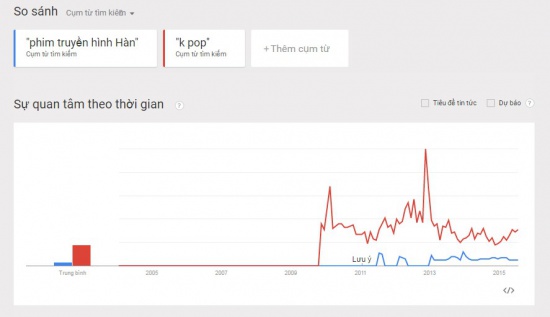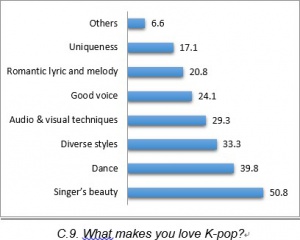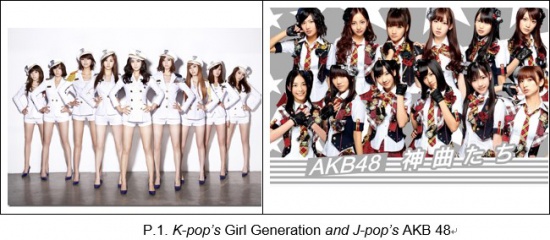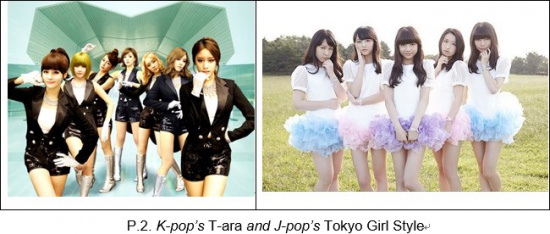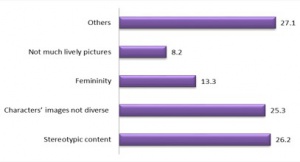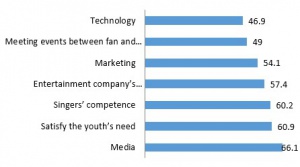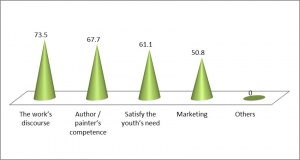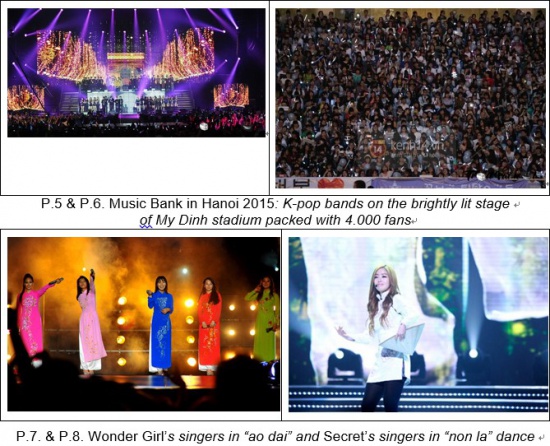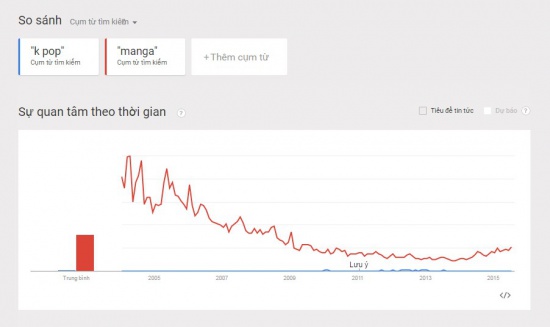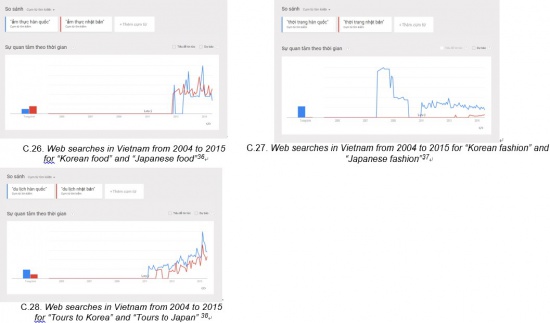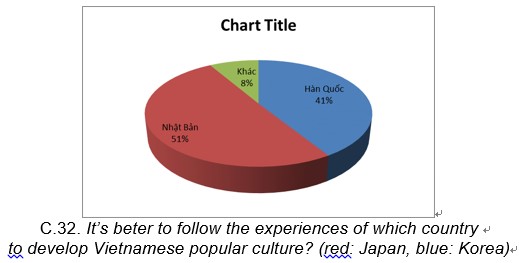THE STRENGTH AND WEAKNESS OF KOREAN WAVE IN VIETNAM(IN COMPARISON WITH JAPANESE ONE)
| Phan Thi Thu Hien | |

| |
| Name in Latin Alphabet: | Phan Thi Thu Hien |
|---|---|
| Nationality: | Vietnam |
| Affiliation: | Ho Chi Minh City University of Social Sciences and Humanities(HCMUSSH) Associate Professor |
목차
- 1 INTRODUCTION
- 2 1. AN OUTLINE OF HALLYU IN VIETNAM
- 3 2. THE STRENGTH AND WEAKNESS OF K-POP IN VIETNAM (IN COMPARISON WITH J-POP)
- 4 3. THE STRENGTH AND WEAKNESS OF MANHWA IN VIETNAM (IN COMPARISON WITH MANGA)
- 5 4. THE STRENGHTH AND WEAKNESS OF KOREA IN BUILDING AND DEVELOPING WAVE EFFECTS AROUND THE IMPORTANT CULTURAL PRODUCTS LAEDING HALLYU (IN COMPARISON WITH JAPAN)
- 6 5. THE STRENGTH AND WEAKNESS OF HALLYU IN DEALING WITH RELATION BETWEEN THE NATIONAL AND THE INTERNATIONAL (IN COMPARISON WITH ILLYU)
- 7 5.3. The reflection of things familiar with everyone in everywhere
- 8 6. THE STRENGTH AND WEAKNESS OF HALLYU IN CREATING CULTURAL CONTENT
- 9 CONCLUSION
- 10 REFERENCES
- 11 각주
- 12 발표문 목록
INTRODUCTION
Korean Wave (Hallyu) came to Vietnam later than Japanese Wave (Illyu). It’s natural that they are in a competitive relation and Vietnamese people when receiving often compare one with other.
Studying the strength and weakness of Hallyu in Vietnam is necessary for both Korea and Vietnam to manage and develop their popular cultures as well as improve Korean - Vietnamese cooperative relation. Although there were some researches on Hallyu and Illyu independently, the theme of comparison Hallyu with Illyu has not been studied systematically and profoundly from Vietnamese perspective.
Our paper is designed to light our basic scientific hypotheses such as following:
(1) Strengths and weaknesses of a certain cultural wave in a foreign environment are not only due to its intrinsic nature but also by its interaction with the culture receiving it.
(2) We can understand strength and weakness of a certain cultural wave through its typical content-based products and its way of building wave effects around these products.
(3) We can understand strength and weakness of a certain cultural wave through its cultural and economic success as well as its effects in building the national image, the national brand.
We apply methodology to study Hallyu and Illyu as popular cultures, consider Vietnamese students’ responses to them as intercultural communication. We would use qualitative and quantitative methods, comparative method and interdisciplinary approach.
We have made a survey on 573 students. The students are an important subject to Hallyu / Illyu.
In regard to student gender, female is 59, 2%; male is 40, 8%. In regard to student’s age, 53, 6% from 15 to 20; 41, 9% from 20 to 25
In regard to student’s birthplace, 64, 7% living in urban and 35, 3% in rural.
They are from 9 universities as well as from 1 high school and 1 secondary school in Ho Chi Minh City, Bien Hoa City (Dong Nai province), Tra Vinh City (Tra Vinh province). Their majors are very diverse: Korean Studies (13,8%), Japanese Studies (21,5%), Southeast Asian Studies, Culturology, Khmer Culture, Tourism, English, Informatics, Physic, Chemical Technology, Food Technology, Electronic, Electromechanical.
Besides the survey, we also analyze public opinions through forums and social networks.
1. AN OUTLINE OF HALLYU IN VIETNAM
1.1. The formation and development of Hallyu in Vietnam
While Illyu (with Manga) came to Vietnam from the beginning of 1990s Hallyu came to Vietnam in 1998 firtsly with the film The Medical brothers broadcasted on Ho Chi Minh City Television (HTV).
The scholars classify Korean products relating to Hallyu into 2 types[1]:
- Content-based products comprise movie, pop music, game online, comic (manhwa)…
- Hardware and services comprise fashion, cosmetic, food, mobile phone, electronic accessories, tourism…
Samsung Economic Research Institute conducted a survey in 2005 and concluded that the process of consuming Korean products relating to Hallyu could be identified in 4 potential stages: (1) The first stage: using the cultural (content-based) products of Hallyu such as K’movie, K’pop; (2) The second stage: buying the products connecting to K’movie or K’pop such as film posters, pictures of Korean actors and actress, Hallyu tours…; (3) The third stage: buying “Made in Korea” goods such as clothing, cosmetics, electronic accessories…; (4) The fourth stage: Having a passion for Korean culture, economy in general. Vietnam can be classified in the third stage.
The process of Hallyu in Vietnam is often divided by many scholars into 3 periods: (1) from 1998 to 2000 - Rising; (2) from 2000 to 2005 - High tide (3) from 2005 up to now - Downstream inclination. However, up to now, Hallyu continues developing. From our point of view, the year 2006 is a landmark where K-pop replaced K-drama to be Hallyu’s “locomotive”.
Hallyu is introduced and developed in the period of innovation, development and integration in Vietnam. The historical and cultural similarities between the two nations make Hallyu easily beloved and shared in Vietnam.
1.2. The pattern of accepting, consuming Korean products relating to Hallyu
As seen in the charts 1 & 2, Vietnamese students like K-pop and consume K-pop second to K-drama. Manhwa is the second last.
In correlation with student’s major, we can see 13,8% of students who like K-pop the most relating to Korean Studies, 21,4% relating to Japanese Studies. And 12,2% of students who often listen to / watch K-pop the most relating to Korean Studies, 21,6% relating to Japanese Studies.
(Using Google Trends to) Comparing web searches for K-drama and K-pop in Vietnam from 2014 to present, we can see that from the end of 2009, concerns for K-pop is increasing and higher than for K-drama.
C.3. Web searches in Vietnam from 2014 to present for K-drama and K-pop[2]
Although being the second to K-drama, it’s K-pop is Hallyu’s leading force in Vietnam nowadays. Because in recent years there has not been any K-drama with high ratings as Winter Sonata, Dae Jang Geum, Jumong Legend of the previous period. Instead of K-drama’s “events” are K-pop’s ones. Especially Gangnam Style in 2012. More and more singer stars are invited acting to attract K-drama’s audiences rather than vice versa. According to a survey in May 2014, "on the network of three national television channels - KBS, MBC and SBS – there are more than 20 K-dramas with the participation of singer stars”. In Vietnam, from 2011, K-pop idols’ tours replace K-drama artists’ ones. Most of “ambassadors” for Korean cosmetic brands are K pop stars. Fan clubs, fan forums relating to Hallyu in Vietnam are also mainly of K-pop. The phenomenon of “Crazy fan” mentioned in Vietnamese media are mainly tied to K-pop.
As seen in the charts 4 & 5, Vietnamese students like Japanese Manga and consume Manga the most. J-pop is the second last.
In correlation with student’s major, we can see 15,8% of students who often read Manga the most relating to Japanese Studies, 12,9% relating to Korean Studies.
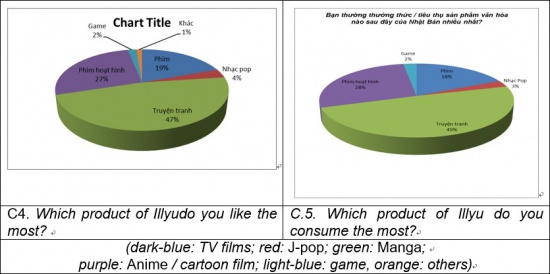
Manga is the important product leading Illyu.
So, K-pop and Manga are worthy to be selected as case studies to analyze the strength and weakness of Hallyu and Illyu.
2. THE STRENGTH AND WEAKNESS OF K-POP IN VIETNAM (IN COMPARISON WITH J-POP)
2.1. An outline of K-pop in Vietnam
Comparing web searches for K-pop and J-pop in Vietnam from 2014 to present, we can see that the concern for J-pop is insignificant.
The concern for K-pop is increasing suddenly at the end of 2010 and especially at the end of 2012 (the time of Gangnam Style).
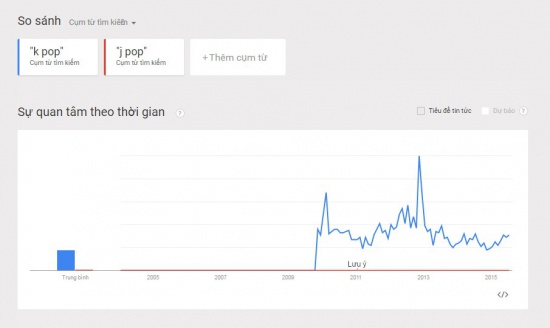
C.6. Web searches in Vietnam from 2014 to present for K-pop and J-pop[3]
As seen in the charts 7 & 8, most of Vietnamese students often enjoy K-pop and J-pop through internet (76% vs. 65%).
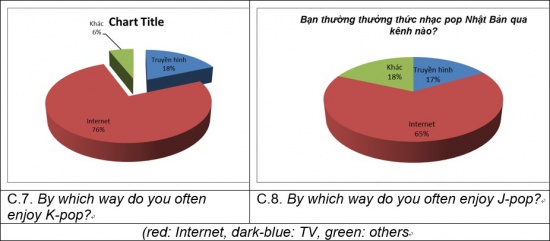
The Internet was introduced in Vietnam in 1997 and has developed extremely fast. As reported by Vietnam Internet Resources, to the end of 2014, the number of Vietnamese domain was 1,015,701, with the highest growth rate all over the world (6.73%). According WeAreSocial, Vietnam has 41 million internet users. On average, Vietnamese Internet user goes online via computer 5 hours and via mobile devices 3 hours per day[4]. According to ComScore’s statistics in March 2013, 4/10 of Vietnamese Internet users are under the age of 24. About 13% of them use the internet to read the news, a higher proportion in comparison with all other Southeast Asian countries. 19.3% of them use the internet to entertain [second to Singapore (19.5%)]. 96% of Vietnamese internet users had used google search[5].
One of the strengths of K-pop in Vietnam is related to the Internet. Every leading entertainment company in Korea efficiently You Tube to publish widely K-pop’s video clips. Because this policy of “Free Sharing”, Vietnamese students can enjoy K-pop. Meanwhile, most of J-pop companies have just upload PV (Promotion Video) part, not the entire of video clips.
According to our survey, there are 10 Korean music bands / singers are considered the idols by Vietnamese students:
| No. | Band / Singer | % of students | Class | Company | The year of debut | The visits to Vietnam |
|---|---|---|---|---|---|---|
| 1 | Big Bang | 30.7 | Male group | YG | 2007 | 2011, 2012, 2015 |
| 2 | EXO | 7.9 | Male group | SM | 2012 | 2015 |
| 3 | Dong Bang Shin Ki (DBSK / DBSQ / TVXQ) | 7.7 | Male group | SM | 2003 | 2012, 2013 |
| 4 | Girl Genaration (SNSD) | 7.2 | Female group | SM | 2007 | 2009, 2012, 2014 |
| 5 | Bi – Rain (Jung Ji Hoon) | 4.5 | Solo, male singer | JYP | 2004 | 2006, 2012 |
| 6 | 2NE1 | 4.4 | Female group | YG | 2009 | 2012, 2014 |
| 7 | T-ara | 3.7 | Female group | CCM MBK | 2009 | 2013, 2015 |
| 8 | BoA (Kwon Bo A) | 3.5 | Solo, female singer | SM | 2000 | - |
| 9 | Psy (Park Jae-Sang) | 1.9 | Solo, male singer | YG | 2012 | - |
| 10 | Super Junior (SJ) | 1.9 | Male singer | SM | 2005 | 2012, 2015 |
As seen, more male groups / singers are favorited than female ones.
SM has the most of the favorited bands / singers (5/1), then YG (3/10) then JYP, CCM / MBK.
Most of K-pop favorited bands / singers have appeared from 2000s. There are only two new names of the year 2012 are Psy and EXO. Compared with
ardent furor for Psy in 2012, that’s the percentage of students considering him as their idol in the middle of 2015 is only 1,9 % showed a rapid decline.
There are 5 Japanese music bands / singers are considered the idols by Vietnamese students:
| No. | Band / Singer | % of students | Class | Company | The year of debut | The visits to Vietnam |
|---|---|---|---|---|---|---|
| 1 | AKB 48 | 19.7 | Female group | Many companies | 2005 | 2012 |
| 2 | (Virtual “diva”) Hatsune Miku | 10.5 | “Solo, female singer” | Crypton Future Media | 2007 | - |
| 3 | Tokyo Girls’ Style | 9.2 | Female group | Avex Group | 2010 | - |
| 4 | Hello! Project | 3.7 | Female group | Up-Front Group | 1998 | - |
| 5 | Exile | 2.8 | Male group | Avex Group | 2001 | 2011 |
Although there are only 5 J-pop bands / singers favorited (fewer than 10 K-pop’s ones), the leading three of J-pop have the percentages of students admiring second to only Big Bang and higher than other Korean bands / singers.
More female groups / singers are favorited than male ones.
Most of J-pop favorited bands / singers have also appeared from 2000s. Hello! Project even was from the end of 1990s.
It’s noticeable that the percentage of students admiring Hatsune Miku (a 3-D Manga character, a humanoid persona voiced by a singing synthesizer application developed by Crypton Future Media) is rather high (10,5%). This shows that Vietnamese students quickly follow the most update trend, they admire modern technological achievement.
2.2. The strength of K-pop in Vietnam
As seen in the chart 9, K-pop is appreciated highly by Vietnamese students in its visual effects (especially singers’ beauty, attractive dance), then technological skills. Singers’ voice quality is not much appreciated. The romance is also not highlighted. K-pop is not valued high in the uniqueness.
In correlation with student’s ages, we can see 15-20 age students love K-pop more warmly than 20-25 students (the percentage of 15-20 group is higher than 20-25 one in every factor). Two groups concur with each other the most in appreciating K-pop’s romance (48, 7% of 15-20 age students vs. 47,1% of 20-25 age students agree). Their opinions different the most are in appreciating K-pop’s uniqueness (57,1 % of 15-20 group vs. 37,8% of the 20-25 group agree).
In correlation with student’s gender, we can see female students love K-pop more passionately than male students (the percentage of female group is much higher than male one in every factor). Two groups concur with each other the most in appreciating K-pop’s attractive dance (40,3% of male students vs. 59,7% of female students agree). Their opinions different the most are in appreciating K-pop singers’ voice quality (70,3% of female group vs. 29,7% of male group agree).
As seen in the chart 10, J-pop is appreciated by Vietnamese students in its singers’ beauty, its romance. In comparison, K-pop is appreciated in more factors than J-pop.
For both K-pop and J-pop, the factor attractive the most is singer’s beauty. The percentage for K-pop (50,8%) is higher than for J pop (49.9%). It seems that the concept of beauty of Korean and Japanese are different. According to Mr. Robert Michael Poole, CEO of Something Drastic International Music Promotion and Tokyo editor at CNNGo, “The Japanese pop market has typically been all about cuteness, presenting boys with the ideal submissive girl to treat like a doll rather than lust over (…) So the Korean boom of girl groups has coincided with the aforementioned social malaise. The K-pop groups are the tonic that the girls in Japan need - new role models that show it’s cool and attractive to be strong-minded”[6].
If "cute” to K-pop means precious ladies, for J-pop it means the style of high school students in uniform.
If “loveable” to K-pop means sexy, for J-pop it means “innocence”.
While many K-pop male singers are complimented as “prettier than girls”, J-pop ones often more manly, even “rough”.
K-pop stars also are appreciated in their elegant costumes. G-Dragon, a member of Big Bang, is famous in his unique fashion style. K-pop stars are especially much more professional than J-pop in Choreography dance. The dances of Sorry Sorry, Gee, Lucifer… of SM’s bands, Tell Me, Heartbeat… of JYP bands are admired in Vietnam.
In regard of lyrics and melody, K-pop as well as J-pop is appreciated in its romance. The percentage for J-pop (24, 8%) is higher than for K-pop (20,8%) a little.
Many K-pop bands / singers (especially of YG) often choose and succeed with R&B which is sweeter, easier to listen than Pop, Hip Hop… K-pop’s lyrics are often easy to pronounce, easy to remember, easy to sing.
Vietnamese pop (V-pop) is influenced much by K-pop not J-pop. Some V-pop’s video clips are K-pop’s “imitation”, from costumes, make-up, dance movements to camera angles and lighting effects…[7]
2.3. The weakness of K-pop in Vietnam
As seen in the chart 11, three important factors make Vietnamese students dislike K-pop (with the same percentage) are the excessive sexy, the mediocre lyric and the stereotypic pattern. They also do not like K-pop ways “too packed”, not natural. However, the percentage for K-pop weakness is lower than for K-pop strength.
In correlation with student’s ages, we can see 15-20 age students also dislike K-pop more than 20-25 students (the percentage of 15-20 group is higher than 20-25 one in most of factors). Two groups concur with each other the most in appreciating K-pop’s stereotypic pattern (the same percentage of 47,8%).
Their opinions different the most are in appreciating K-pop’s mediocre lyric (56, 5 % of 15-20 group vs. 38,4% of the 20-25 group agree).
In correlation with student’s gender, we can see female students also dislike K-pop more sharply than male students (the percentage of female group is much higher than male one in every factor). Two groups concur with each other the most in appreciating K-pop’s excessive sexy (44,2 % of male students vs. 55,8% of female students agree). Their opinions different the most are in appreciating K-pop singers’ stereotypic pattern (70,2% of female group vs. 29,8% of male group agree).
As seen in the chart 12, the two important factors make the students dislike J-pop are not much innovative and not much diversified styles. They also dislike J-pop’s not much attractive and not much talented singers.
In comparison, J-pop is criticized in more factors than K-pop.
While J-pop singers are not satisfied because lack of sexy, K-pop singers are not satisfied more because of excessive sexy. Many K-pop’s female bands choose too short skirts or hot pants, too tight pants to be performance garment. The important thing is that while J-pop singers nearly do not influence on public’s trends of fashion, many K-pop stars become trendsetters who have much impact on Vietnamese youth. Many Vietnamese students / pupils also wear short skirts and hot pants in the streets or going to schools. Such images make old people have negative feelings to K-pop singers.
In regard of lyric, not rare popular hit songs translated into Vietnamese are bland, even nonsense, meaningless with “too many repeated words, many grammatical errors, many English words not relating to the content, and even slangs…” On some Vietnamese forums and social networks, many examples are criticized [many repeated words in T-ara’s “Bo Peep Bo Peep", “Lovey Dovey”; SHINee’s "Ring Ding Dong"; Secret’s "Madonna"; Sistar’s "So Cool"; f (x)’s "Hot Summer"…, nonsense English words in Teen Top’s "Crazy", Block B’s "Go Crazy"…; slangs in NS Yoonji’s “The Reason I Became a Witch”, GD & TOP’s "Knock Out"; bland lyrics in Super Junior’s “Bonama”, Girl Generation’s “Bring the boys out”... K-pop music critic Im Jin-mo said:
“Pop music implies a mass appeal, but if the lyrics can’t capture a broad audience it could damage the current boom of K-pop overseas[8]”.
Some Vietnamese young people made comparison K-pop lyric with J-pop. For them, J-pop themes are richer: not only about love between man and woman but also family affection, friendship, many aspects of life. Many successful J-pop works bring profound discourses on the meaning of life, youth aspirations…The examples are analyzed from Kobukuro “Wadachi”, “Kazamidori”, Ryusei”… “The songs you will hear and feel with the whole of your heart[9]”.
In regard of stereotypic patterns, it is not only the lack of style diversity between singers in a same group (“every member of Suju, SNSD, SHINee… follows the same dance movements[10]”) but also the lack of style diversity between different bands of a same entertainment company (“most of SM’s products are similar[11]..”)
K-pop is famous for careful and professional selection and training singers. This create K pop singers with comprehensive and diverse capabilities, but also make impression of its “too packed” not natural manner. Ms. Janice Min, a Korean prestigious critic of US media emphasized: "The weakness of K-pop is its not true sensation”[12].
3. THE STRENGTH AND WEAKNESS OF MANHWA IN VIETNAM (IN COMPARISON WITH MANGA)
3.1. An outline of Manhwa in Vietnam
Manhwa (Korean comic / cartoon) were imported into Vietnam from the late 1990s (Korean Fairytale was the first Manhwa work published in Kim Dong Publishing House in 1999), a decade later than Japanese ones. Since 2010, Manhwa began to bloom, with a series of works, mainly in the Time Publishing House, then Kim Dong Publishing House, Youth Publishing House and some local publishers (in Hanoi, Dong Nai, Thanh Hoa....).

Comparing web searches for Manhwa and Manga (Japanese comic / cartoon) in Vietnam from 2014 to present, we can see that concern for Manhwa is unnoticeable. The concern for Manga is decreasing with a slight increase from 2014.
According to our survey, the percentage of students reading Japanese Manga on Internet (47, 3%) is higher than of buying books to read. In 2014, after informing a new legislation to protect Anime and Manga copyright, the Japanese government announced the list of websites violating regulation. Two Vietnamese websites related to it are Manga24h and XemPhimSo[14].
According to Nguyen Thi Hien’ survey (on 296 students in Ho Chi Minh City), there are 50% reading Korean Manhwa on Internet and 25% buying books to read[15].
Recently Vietnamese young people begin paying attention to Korean Webtoon (web + cartoon) with Manhwa works can be read on smartphone. Some Korean scholars hope that K’webtoon will become leading Hallyu in a near future.
According to our survey, there are 3 Manhwa works favorited the most by Vietnamese students (with the percentage more than 10%):
| No. | Manhwa work | % of students | Genre | Author | The 1st publication in Vietnam |
|---|---|---|---|---|---|
| 1 | Full House | 35.3 | Sunjeong (romance) | Won Soo Yeon (female) | 2005 |
| 2 | Goong | 19.2 | Sunjeong (romance) | Park So Hee (female) | 2005 |
| 3 | A playful troop | 16.9 | Myeongnang (story on martial arts – humor) | Park In-seo, Choi Sang | 2012 |
Sunjeong Manhwa (순정만화, girl’s comic) is more favorited than Myeongnang Manhwa (명랑만화, boy’s comics. Moreover, 2 of 3 works are by female authors. According to Nguyen Thi Hien’s survey, Sunjeong Manhwa is favorited mainly by female students and Myeongnang Manhwa by male ones.
Both Full House and Goong were adapted into movies (in 2004 and 2006). They belong to top five K-dramas being adapted successful the most. They are very passionate in Vietnam. Especially, Vietnamese version of Full House movie is also paid much attention. These contribute to the youth’s interest in Manhwa works.
Japanese Manga is more successful. In Vietnam, there were more than 20 millions copies of Doraemon issued in Vietnam. 6 Manga works are favorited the most by students with the percentage higher than 15%.
| No. | Manhwa work | % of students | Genre | Author | The 1st publication in Vietnam |
|---|---|---|---|---|---|
| 1 | Doraemon | 65.3 | Science fiction - Humor | Fujiko Fujio | 1992 |
| 2 | Conan | 49.4 | Detective | Gosho Aoyama | 2000 |
| 3 | Naruto | 24.3 | Action, Adventure, Science Fiction, | Kishimoto Masashi | 2003 |
| 4 | Dragon Ball | 21.3 | Material Arts, Science fiction | Toriyama Akira | 2003 |
| 5 | Sailor Moon | 16.8 | Mahou Shoujo (girl’s comic), Magic | Takauchi Naok | 1995 |
| 6 | One Piece | 16.2 | Action, Adventure, Science Fiction - Humor | Eiichiro Oda | 2009 |
5 of 6 works belong to Shonen Manga (少年漫画, boy’s comic), only 1 Shoujo manga (少女漫画, girl’s comic). While Korean boy’s comic is mainly favorited by male students, Japanese boy’s comic is favorited by both male and female.
While Korean successful Manhwa works often are adapted into movies, Japanese Manga works often are adapted into Anime. 6 Manga works aforementioned were adapted into Anime. Conan and One piece were also adapted into movies.
Korean Manhwa is introduced in Vietnam later than and has less attraction than Japanese Manga. Full House with high percentage is an exception.
3.2. The strength of Manhwa in Vietnam
As seen in the chart 14, Vietnamese students like Korean Manhwa because of its romantic and lovely content, its good picture, and its humor.
In correlation with student’s ages, we can see 15-20 age students like Manhwa more than 20-25 students (the percentage of the 15-20 group is higher than the 20-25 one in all of factors). Two groups concur with each other the most in appreciating Manhwa’s romantic and lovely content (49,3 % of the 15-20 group vs. 46,9 % of the 20-25 group agree). Their opinions different the most are in appreciating Manhwa’s good picture and design (53,8% of the 15-20 group vs. 40,7% of the 20-25 group).
In correlation with student’s gender, we can see female students like Manhwa more than male students (the percentage of female group is much higher than male one in every factor). Two groups concur with each other the most in appreciating Manhwa’s humor (43,7% of male students vs. 56,3% of female students agree). Their opinions different the most are in appreciating Manhwa’s romantic and lovely content (70,3% of the female group vs. 29,7% of the male group agree).
As seen in the chart 15, Vietnamese students like Japanese Manga because of its excellent picture, diverse genres, distinctive content, reflected Japanese culture and spirit.
In correlation with student’s ages, we can see 15-20 age students like Manga more than 20-25 students (the percentage of the 15-20 group is higher than the 20-25 one in most of factors). Two groups concur with each other the most in appreciating Manga’s diverse genres satisfying readers’ diverse needs (50,4% of the 15-20 group vs. 44,5% of the 20-25 group). Their opinions different the most are in appreciating Manga’s excellent picture (53, 7 % of the 15-20 group vs. 42,2 % of the 20-25 group agree).
In correlation with student’s gender, we can see female students like Manga more than male students (the percentage of female group is much higher than male one in every factor). Two groups concur with each other the most in appreciating Manga’s excellent picture (45,5 % of male students vs. 54,5% of female students agree). Their opinions different the most are in appreciating Manga’s diverse genres (70,2% of the female group vs. 29,8% of the male group agree).
Despite there are some strengths, Korean Manhwa still do not have unique characteristics capable to compete with the Japanese Manga. In regard of genres, Japanese Manga is more diverse. As seen in charts 3 and 4, the Manga works favorited by Vietnamese students are more diverse than Manhwa.
In regard of form, Japanese Manga’s overwhelming success is in expressing subtly its characters’ innermost feelings. Manga use a kind of “slow motion” when using many pictures to present a gesture or a particular emotional state during its complex and exquisite movement process. In regard of content, Korean Manhwa works based on romantic and gentle humor stories while Japanese Manga is “not merely for entertainment”. Manga “reflect many diverse issues in life”. A lot of Japanese Manga works do not have a happy end, leaving many things to be contemplated. Japanese Manga characters do not possess supermen’s competence. Even the characters having magic still bring human weakness and limits. There are no perfect ideal heroes as well as no completely evil characters.
In general, there are still rare Manhwa works with profound messages.
3.3. The weakness of Manhwa in Vietnam
As seen in the chart 16, Vietnamese students dislike Korean Manhwa’s stereotypic content, characters’ images not diverse, femininity, not very much lively pictures.
Korean Manhwa is criticized that different characters are showed off the same. There is no strong distinction between male and female characters, between one personality and the other. Such differences in form and style are formalized sharply in Japanese Manga, for example, “to draw man’s hand with thickness and draw woman with slender hand”, “to draw woman’s eye with long and curved lashes, man’s eye with rough eyelids”, “to draw woman with round face and man with angular face…[16]”
The "femininity" make Korean Manhwa being favorited is also make it become bored.
As seen in the chart 17, Vietnamese students dislike the sexy and violence in Japanese Manga.
In correlation with student’s ages, we can see 15-20 age students dislike Manga’s sexy and violence more than 20-25 students (the percentage of the 15-20 group is higher than the 20-25 one in both of 2 factors: 52,1% and 47,9% vs. 43,6% and 44,9%).
In correlation with student’s gender, we can see female students dislike Manga’s sexy and violence more than male students (the percentage of female group is much higher than male one in both of 2 factors: 65,7% and 65,3% vs. 34,3% and 34,7%).
In comparison with Japanese Manga, Korean Manhwa is much more moderate in sexy and violence’s expression. That’s why Manhwa is easier than Manga to be received by Vietnamese. Both Vietnamese and Korean cultures are influenced by Confucianism deeply for a long time. Both Vietnam and Korea today have a high rate of Buddhist and Christian (while most of Japanese people follow Shinto beliefs).
4. THE STRENGHTH AND WEAKNESS OF KOREA IN BUILDING AND DEVELOPING WAVE EFFECTS AROUND THE IMPORTANT CULTURAL PRODUCTS LAEDING HALLYU (IN COMPARISON WITH JAPAN)
4.1. An outline of the way of building and developing wave effects around the important cultural products leading Hallyu
Around K-pop, systems of its related diverse products, services and activities are created and operated to build and develop wave effects of not only K-pop in particular but also of Hallyu in general. And the most important is to promotion Korean brand (“made in Korea” things). These systems are based on building “idol culture”.
As seen in the chart 18, the most is students watching their idol’s video clips as well as the TV programs and K-dramas which their idol participates in. Then, they sing their idol’s song; buy picture, posters, T-shirts relating to their idol. With the low percentage are covering / attending cover shows of their idol’s works; imitating their idol’s fashion, make-up and behavior; participating in forums on their idol; attending their idol’s live shows / concerts…
In correlation with student’s ages, we can see 15-20 age students show the favor for their idol more warmly than 20-25 students (the percentage of the 15-20 group is higher than the 20-25 one in almost of factors; only 1 exception as fashion, make-up, behavior like idol is with higher percentage of 20-15 age students ). Two groups concur with each other the most in watching their idol’s video clips and the TV programs, K-dramas… (50,6% of the 15-20 group vs. 44,8% of the 20-25 group). Their opinions different the most are in covering / attending cover shows of their idol’s works (68,9 % of the 15-20 group vs. 28,9 % of the 20-25 group agree).
In correlation with student’s gender, we can see female students show the favor for their idol more warmly more than male students (the percentage of female group is nearly doubly male one in every factor). Two groups concur with each other the most in watching their idol’s video clips and the TV programs, K-dramas… (46,7 % of male students vs. 53,3% of female students agree). Their opinions different the most are in imitating their idol’s fashion, make-up and behavior (65,8% of the female group vs. 34,2% of the male group agree).
Around Manga, we do not see clearly Japanese strategies / tactics in building and developing systems of products, services, activities to promoting Japanese brand (“Made in Japan” things).
As seen in the chart 19, the most is that Vietnamese students often watch anime / film adaptation of Manga works. Then is that they buy pictures, dresses, toys… relating to Manga characters. With very low percentage are participating in forums on Manga; attending Manga Festival, Cosplays; drawing Manga; Making parody Manga.
In correlation with student’s ages, we can see two groups concur with each other the most in participating in forums on Manga (with the same percentage of 44,4% for two group). Their opinions different the most are in drawing Manga (66,7 % of the 15-20 group vs. 33,3 % of the 20-25 group agree).
In correlation with student’s gender, we can see two groups concur with each other the most in making parody Manga (40 % of male students vs. 60% of female students agree). Their opinions different the most are in drawing Manga (16,7% of the male group vs. 83,3% of the female group agree).
In comparison, the activities surrounding K pop idols are more diverse and abundant than the activities around Japanese Manga works.
4.2. The strength of Korea in building and developing wave effects
As seen in the chart 20, according to Vietnamese students’ opinion, the very important factors for K-pop’s success are Media; Meeting the youth’s need; Singers’ competence; Entertainment company organization; Marketing; Meeting events between fans and their idols, technology.
As seen in the chart 21, according to Vietnamese students’ opinion, the very important factors for Manga’s success are Work’s discourse; Author / painter’s competence; Meeting with the youth’s need; Marketing.
Vietnamese students find more significant for K-pop’s success are Media, Meeting the youth’s need while more significant for Japanese Manga’s success are its intrinsic qualities (The work’s discourse; Author / painter’s competence). We will make comparisons: (1) between K-pop and J-pop stars’ visit tours to Vietnam; (2) between Korean Manhwa and Japanese Manga events in Vietnam.

Firstly, on K-pop and J-pop stars’ visit tours to Vietnam.
Searching in Google (in 4 August 2015) with key words of “Sao Han den Viet Nam” (“Korean stars’ visits to Vietnam”), we find 8.950 results in 0,23 seconds while with “Sao Nhat den Viet Nam” (“Japanese stars’ visits to Vietnam”) we find only 8 results in 0,83 seconds.
Among 5 of the most favorited J-pop bands / singers (in the table 2), a sub-group of AKB 48 came to Hanoi in 2012, on the occasion of 40 years of Vietnam-Japan relation. This event made only slight ripple in media. The fans can find on internet the pictures of Japanese singers walking around in Hanoi. Many fans like their friendly manner (“not be separated as Korean stars”). However, many fans have complained that "AKB’s core members did not come"; and “the group was not welcomed by any fan club’s event”; “when they sing, a few of audience gave cheering”, “perhaps this is the last time AKB 48 to Vietnam”[18].
And what about K-pop? Among 10 of the most favorited bands / singers (in the table 1), only BoA and Psy did not come to Vietnam. From 2011 up to now, during 4 years, 8 bands / singers visited Vietnam, most of them came two times, Big Bang and Girl Generation (SNSD) came three times.
While J-pop singers’ tours to Vietnam, in general, are official diplomatic events, K-pop singers’ tours belong to entertainment area, belong to the youth culture and are organized by entertainment companies, supported by cosmetic and other manufacture companies.
When visiting Vietnam in 2010, Mr. Myoung Hi-Jun, the Deputy-Head of JYP Market Research presented his opinion, showing very clearly the strategic interest of Korean largest entertainment companies in offering big investments for K-pop stars’ touring abroad: "We have a very clear strategy to develop cultural export. From our point of view, the Korean artists, while performing in a certain foreign country, they contribute to promoting Korean culture. The artists understand that they do not simply sing to the audience or only because of his passion"[19].
All of K-pop stars’ tours in Vietnam are organized to become very impressive spectacular events which cause “storms” in media, on social networks as well as in real life of fans. The fans welcome their idols at the airports, follow their idols to the hotels. The performances are in big stadiums crowded with 4.000 – 5.000 audiences and flooded with flags, balloons, band rolls… and passionate cheers. At KBS’s Music Bank in Hanoi program (in March 2015), the organizers used new technology of light-stick: every fan is given a clock change color according to songs.
K-pop stars are admired by not only artist competence but also “fan-service technology”. They are trained to become not only singers but idols”. They often smile brightly, talk friendly, make jokes joyfully… Every star can greet and thank the audience with a few words in Vietnamese. Some stars ven choose to sing a Vietnamese song. The singers of Wonder Girl band perform in “ao dai” (Vietnamese traditional dress). The Secret band dance with “non la” (Vietnamese popular hat). The pictures shooting K-pop stars (Baekhyun, Sehun, D.o of EXO or Bambam of Got7 ...) eating “pho” (Vietnamese noodle soup) are also uploaded on social networks by the singers themselves: “They understand the powerful force of simple messages”[20].
Besides the power of technology, modern advertising skills, K-pop events’ success is based on principles of making aspiration and interaction with audience which are typical in Korean traditional performances and at the same time familiar with Vietnam traditional theaters.
Secondly, on the events promoting Korean Manhwa and Japanese Manga in Vietnam.
Korean Manhwa came to Vietnam 16 years ago. However, it seems that there have been not much attention for promoting Manhwa. Only 1 exhibition with paintings of Manhwa characters was held in Korean Cultural Center in Hanoi. When the children coming, they were given a Manhwa book.
| No. | Event | Organizers | Time | Venue |
|---|---|---|---|---|
| 1 | The exhibition on The paintings of comic characters and Korean comic | Korean Cultural Center in Vietnam, KOCCA | 26/5-1/6/2013 | The exhibition room, Korean Cultural Center in Vietnam |
Meanwhile, there are more events promoting Japanese Manga in Vietnam. Besides large-scale exhibitions, there are also science conferences, lectures on Manga organized by Japanese government offices, artist associations, universities in cooperation with Vietnamese ones.
| No. | Event | Organizers | Time | Venue |
|---|---|---|---|---|
| 1 | The conference on Exploring cultural identity in Japanese Manga and Anime | Tokyo Foundation, The Embassy of Japan & Kim Dong Publishing House, The Youth Publishing House | 2&3/12/2005 | Hilton Opera Hotel, Hanoi& New World Hotel, Ho Chi Minh City |
| 2 | International MANGA Award | Ministry of Foreign Relation, Japan Foundation & Manga Association | 2007 | |
| 3 | The major Manga began its enrollment | Hong Bang University | From 2007 | Hong Bang University, Ho Chi Minh City |
| 4 | Manga Festival | The Youth Cultural House | Annual events from 2010 | The Youth Cultural House, Ho Chi Minh City |
| 5 | Special lecture on “Japanese Manga: an entertainment going cross times and spaces | Vietnam University of Fine Arts | 19/5/2011 | Vietnam University of Fine Arts, Hanoi |
| 6 | The exhibition on The New Space of Manga – Japanese modern comic arts | The Embassy of Japan, Center of Japanese-Vietnamese Cultural Exchange in Vietnam & Kim Dong Publishing House | May and June 2011 | Vietnam Museum of Fine Arts (Hanoi) |
| 7 | The exhibition ESHI 100 (105 Manga and Anime works) | Green Wood Company, Sankei Shimbun & Tien phong Newspaper | 8-16/3/2013 | Ho Chi Minh City Exhibition House |
| 8 | The conference on Japanese comic | Japan University of Fine Arts and Design | 25/11/2014 | University of Industrial Design, Hanoi |
It’s noticeable that Manga belong to popular culture which is often considered as low, unofficial, marginal culture is deliberately put by Japanese in the atmosphere of elite cultre which is often considered as high, official, mainstream culture (scientific conferences, academic lectures, exhibitions, international contests on Manga are organized with the participation of scholars, artists, painters, students… in the National Museum of Fine Arts, National University of Fine Art…).
Therefore, the wave effects of Manga in Vietnam are not only Manga festivals, Cosplay festivals by young people. The major on Manga was established in Hong Bang University from 2007. Annual contests for creating comics are organized by Kim Dong Publishing House. The Education Publishing House launched a contest for creating cartoon textbooks on Vietnamese history. "Manga has really become the driving force and inspiration for Vietnamese comics”[21]. A series of comic works on Vietnamese child geniuses which are influenced by Manga style were published and received warmly by students and their teachers, their parents.
The way of promoting popular cultural products by putting them in elite, academic atmosphere is also used for J-pop. In October 2019, when Japan launched Venus Climate Orbiter, three aluminum plates with the images of the Vocaloid Hatsune Miku and her super deformed figure Hachune Miku were also brought to Venus[22].
4.3. The weakness of Korea in building and developing wave effects
The wave effects arounds K-pop are based on the “idol culture”. Not rarely Vietnamese students become “crazy” with their idol. They try to dress, make-up, dye their hair, even do plastic surgery to look like their idol. When K-pop stars visiting Vietnam, they try at all costs to buy tickets which are very / too expensive for them (the official price for the best ticket of Music Bank in Hanoi 2015 program is 4 millions VND and the price in black market is much more) for attending the events. They have some excessive reactions while expressing their love to idol. And they are dissatisfied with their parents, teachers… who criticizing their bahavoirs.
Of course, these things are related to the management of mass culture as well as to the education in Vietnam, not the fault of K-pop. However, we can not say that these things do not affect the strength of K-pop in Vietnam.
Searching in Google in 4 August 2015 with Vietnmaese key words “Nhung nguoi thich K pop” (“The people who like K-pop”), we found proximately 2.360 results (in 1,12 seconds) while 789 results (in 0,32 seconds) of “Nhung nguoi ghet K pop” (The people who dislike K-pop”) and 2.510 results (in 0,14 seconds) of “Anti fan cuong K pop” (“Anti crazy fans of K-pop”). It means that in Vietnam the number of people who like K-pop are more than people who dislike K-pop, however, the number of people “anti crazy fans of K-pop” are much more than people who like K-pop.
Meanwhile, there are proximately 39.600 results (in 0,38 seconds) of “Nhung nguoi thich Manga” (“The people who like Manga”), only 1 result (in 0,47 second) of “Nhung nguoi ghet Manga” (“The people who dislike Manga”), 0 result of “An ti fan cuong Manga” (“Anti crazy fans of Manga”). That’s the young people in Vietnam buy Japanese Manga works or go to exhibitions on Manga do not upset their parents. Their parents even voluntarily buy Manga books for them, go together with them to the exhibitions. There is not any “generation conflict”.
Furthermore, Hallyu events which are organized by entertainment companies and cooperated with cosmetic / electronic… companies, of course, always link cultural and economic profits. Whenever culture-econmy relation is not set in harmony, it may reduce Hallyu’s power. For example, to have 1 of 3.000 tickets to attend the meeting fan event with Kim Hyun Joong in February 2011 in Ho Chi Minh City, each fan-customer have to pay 10 milions / 20 milions / 50 milions VND buying The Face Shop products.
Many fan-customers complainted after purchasing Beyond cosmetic products with at least 1.5 milions VND (its price in black market is 5.5 million VND) to get a VIP ticket, they had opportunity to “see Kim Soo Hyun in only 20 minutes”. “Thousands of fans were disappointed” because the event was"very lean", "very poor", "very cursory”, “as only a repayment"[23].
So, Korea and Japan have different ways of building and developing wave effects around the important products leading their popular cultures. K-pop’s wave seems more boisterous and spectacular while Japanese Manga’s wave seems more quietly, tacit but deeper.
C22. Web searches in Vietnam from 2004 to 2015 for K pop and Japanese Manga[24] As seen in the chart 22, web searching of K-pop in Vietnam is still lower than of Japanese Manga although the care about Manga tends to decline.
5. THE STRENGTH AND WEAKNESS OF HALLYU IN DEALING WITH RELATION BETWEEN THE NATIONAL AND THE INTERNATIONAL (IN COMPARISON WITH ILLYU)
As seen in the chart 23, Vietnamese students think that the most important thing make Hallyu’s artifacts attractive to foreigners is its reflection of unique “Korean identity”. The second is the mixture of Asian and Western values. The last is the reflection of things familiar with everyone in everywhere.
In correlation with student’s ages, we can see two groups concur with each other the most in Hallyu’s reflection of things familiar with everyone in everywhere (47,6% of the 15-20 age group vs. 45,7% of the 20-25 age group). Their opinions different the most are in Hallyu’s reflection of unique “Korean identity” (53,5 % of the 15-20 group vs. 41,9 % of the 20-25 group agree).
In correlation with student’s gender, we can see two groups concur with each other the most in Hallyu’s mixture of Asian and Western values (43 % of male students vs. 57% of female students agree). Their opinions different the most are in Hallyu’s reflection of things familiar with everyone in everywhere (34,3% of the male group vs. 65,7% of the female group agree).
As seen in the chart 24, Vietnamese students think that the most important thing make Illyu’s artifacts attractive to foreigners is the reflection of unique “Japanese identity”. The second is the reflection of things familiar with everyone in everywhere. The last is the mixture of Asian and Western values.
In correlation with student’s ages, we can see two groups concur with each other the most in Illyu’s mixture of Asian and Western values (47,1% of the 15-20 age group vs. 51% of the 20-25 age group). Their opinions different the most are in Illyu’s reflection of things familiar with everyone in everywhere (62,5 % of the 15-20 group vs. 31,3 % of the 20-25 group agree).
In correlation with student’s gender, we can see two groups concur with each other the most in Illyu’s mixture of Asian and Western values (45,1% of male students vs. 54,9% of female students agree). Their opinions different the most are in Illyu’s reflection of unique “Japanese identity” (39,6% of the male group vs. 60,4% of the female group agree).
5.1. The reflection of national identity
According to Vietnamese students’ opinion, the most important thing make both Hallyu and Illyu attractive to foreigners are the reflection of national identity. On this factor, the percentage for Illyu (75,4%) is 1,5 times higher than for Hallyu (49,6%).
Japanese Manga is more interested in reflecting and shaping Japanese unique characters, Japanese unique spirit. As seen in the chart 25, the most impressive Japanese characters, for Vietnamese students, are the will of improving oneself, the unity, a strong sense of disciplinary, the altruism, the dedication to completing mission.
In correlation with student’s ages, we can see 15-20 age students show their admiration for Japanese characters more warmly than 20-25 students (the percentage of the 15-20 group is higher than the 20-25 one in almost of factors). Two groups concur with each other the most in Japanese’s strong sense of disciplinary (45% of the 15-20 age group vs. 49,7% of the 20-25 age group). Their opinions different the most are in Japanese’s altruism (61,7 % of the 15-20 group vs. 36 % of the 20-25 group agree).
In correlation with student’s gender, we can see female students show their admiration for Japanese characters more warmly than male students (the percentage of the female group is higher than the male group). Two groups concur with each other the most in Japanese’s dedication to completing mission (52% of male students vs. 48% of female students agree). Their opinions different the most are in Japanese’s altruism (37,7% of the male group vs. 62,3% of the female group agree).
Compared with Japanese Manga, Korean Manhwa lacks the works reflecting powerfully Korean unique characters, a system of Korean values.
In our survey on 1114 students / pupils of 14 universities, colleges, high schools and secondary schools in Ho Chi Minh City, Bien Hoa (Dong Nai), Da Lat (Lam Dong), Nha Trang (Khanh Hoa) in April and May 2012, replying for our question “Through Hallyu, how do you imagine about Korean people?”, the students / pupils’ answers were rather scattered and not very detailed. They often think that Korean people are romantic, Korean people attach much importance to family relation, attach much importance to social hierarchy.
In general, it seems that Korean popular cultural products build and propagandize the national image less lively and poerfull than Japanese.
5.2. The mixture of Asian and Western values
As seen in the chart 23 and 24, the percentage for Hallyu’s mixture of Asian and Western values is nearly 4 times higher than for Illyu (34,9% vs. 8,9%).
According to Eun-Young Jung[25], the transnational and hybrid values of K-pop are responsible for its success.
When visiting Vietnam in February 2012, Prof. Mun-Woong Lee, Seoul National University, referred Korean characteristic of “bibimbap culture” (“mixed rice” culture)[26]. From the same viewpoint, Mr. Lee Moon Won, one of influential pop culture critics analyzed that: “With K-pop, the song writers are not Korean. They are European. The people who do the editing studied in the United States; they are multinational. The dance choreographers are from everywhere. It’s really a factory (…) The European sound influence is electronic and techno music[27]”.
Because Korean language is not a popular one in the world, in K-pop songs, there are many English words intermingled with Korean ones, English words are especially used in catch phrases for oversea fans easily embrace[28]. This differs from J-pop. Even the subtitles of J-pop songs rarely are translated into English, that’s why it become difficult for foreigners to search.
K-pop always directs to foreign markets besides local market. For example, EXO band has 2 sub-groups: EXO-K and EXO-M, simultaneously released their songs in both Korean and Chinese languages to meet the needs of both Korean and Chinese customers.
The transnational and hybrid characteristic make Hallyu, with its innovation and dynamic, attractive to Asian youth people who admire Korea’s leapfrogging from a backward agriculture to a high-developed country in less than four decades and at the same time still upholding their Asian cultural values, using these values as a motive power to develop economy as well as reform politics.
However, because of this hybrid, among Vietnamese public opinions, there are many worries on the youth’s losing their national traditional culture due to passion to Hallyu.
In V-pop, there are more and more songs mixed English with Vietnamese words. There are more and more Vietnamese singers choose for tthem exotic artist names mixed Vietnamese with English or Chinese words.
5.3. The reflection of things familiar with everyone in everywhere
Mr. Kim HO Sang, Director of KBS’s Music Bank program, in the event in Hanoi in March 2015 stated: “The secret of K-pop’s success is its global theme”[29]. It means that it’s not necessary for K-pop to focus on nationalism. K-pop directs to things familiar to everyone in everywhere, easy for everyone in
everywhere to love, to remember and follow. Psy’s Gangnam Style is such a success.
At its beginning, Hallyu was a success of cultural nationalism emphasizing the existence of “Korean authentic culture”. After that, Koreans go to realize that if Hallyu is driven by aggressive nationalist impulses, it will be at its worst. Mr. Park Jin-Young, one of Korean famous celebrity music producer has said many times that “It only hurts us if Koreans stress the Korean label too much”. Mr. Park emphasized: “You can become a global success if you do something well, whether it is Korean or not. We still lack diversity, yet are strong in uniformity.” While Koreans nowadays direct to globalization of Hallyu, of course, they direct to make Hallyu’s cultural products surpass “Korean authentic value” to contain “universal values”, so that Hallyu can get more appealing to non - Koreans, even, non - Asians.
This makes Hallyu very different with Illyu. “Most of Japanese people think that Japanese culture and tradition, basically, belong to Japanese people and this make Japanese culture unique”. Japanese cultural products are created firstly for Japanese themselves and after that, the foreigner are “conquered” because of its uniqueness. By the late 2000s, Japan began to appreciate the important of cultural diplomacy. However, even in the strategy of cultural diplomacy in the 21st century (with Three Goals and Three Pillars) which was announced in December 2005 there was still not a clear strategy for the development of popular culture as well as the cultural export[30].
Certainly, Korean Government goes ahead with realization of soft power in the age of globalization.
6. THE STRENGTH AND WEAKNESS OF HALLYU IN CREATING CULTURAL CONTENT
Mr. Lee Moon Won, one of the most influential pop culture critics, also “made a shockingly frank pronouncement in describing K-pop”: “Koreans are not good at creativity (…) “Koreans are better at packing and marketing” . We do not think so. From our viewpoint, in regard of popular culture, Koreans are very good at creativity. With spectacular success of K-drama and K-pop, we can say about a take-off of Korea in popular culture in less than 20 years. And we have the right to believe in Korea’s success in Webtoon in a near future. However, compared to Japanese, Koreans are much more innovative in packing and marketing, but less innovative and less persuasive in creating cultural content. Some key advantages which are responsible for Hallyu’ success sometimes become its weakness.
6.1. Feminine attraction of Hallyu
Hallyu’s products such as K-drama, K-pop, Manhwa, K-fashion… are very feminine. The term “feminine” is used by us not only with the sense belongs to sexology but also relating to yin-yang principles.
From our point of view, in comparison, Hallyu seems more feminine while Illyu more masculine.
With feminine attraction, Hallyu easily conquer young people in Asia in general and in Vietnam in particular. The basic reason may be that both Vietnamese and Korean culturea are Oriental ones with feminine / “yin” inclination.
However, students as the young, in nature, are “yang”. That’s why, in one hand, Vietnamese students are moving in Hallyu’s warm atmosphere of family ties and noble, selfless loves, in another hand, they are easily tired of the “mawkish”. They like Korean stories which mainly dealing with everyday events have very familiar tones and at the same time they are captive by science fiction, adventure, magic stories… They are appealed by the moral values in Korean stories tending to end with the triumph of good over evil, but they are also “allergic” to simple plots with arrangements of chances or “fairy-tale” miracles… Repeated motives, rhythms in Korean movie or popular music easy to remember, easy to follow can create “nostalgia” effects but gradually become monotonous for the young who seeks for the new, the creative. They may be infatuated with a spotless beauty, cute appearance but they also feel admiration for something powerful, effective.
6.2. The convergence of Hallyu
A typical feature of popular culture is its convergence - the convergence of diverse arts, converging arts and technology, and the most important, convergence economic and culture.
Manga contributed a lot to the Japanese economy. “According to the staticstics of Japan Bank, from 1997 to 2006, the total value of exports of Japan has increased 1.7 times, among which, the exports of cultural products increased more than threefold. Exports of Japanese Anime to US television has also triple over the exports of stell products”[31].
It’s the same with Hallyu. According to Mr. Choon Keun Lee, The President of KOCCA (Korea Culture and Content Agency), “For every 100 USD of K-pop products exported there will be about 395 USD of information technology products also exported as “followers”[32].
By actively supporting the penetration of Korean culture into foreign markets, linking the boom in popular culture to the market distribution system, Hallyu is a success of Korean “cultural industry.” But it seems that Koreans always need be prudent that an excessive commercialism will be a threat to the development of Hallyu. According to Lee Dong Yeun[33] , a cultural critic, (in his paper titled as “Korean cultural capital’s phenomenon and cultural nationalism”), if Hallyu is limited to unilateral export of popular cultural products and becomes viewed as “a product of shallow capital culture” with an export-oriented state and short-term capitalist logic, if Hallyu like a goose that lays golden eggs and which is on the verge of being butchered by the greedy farmer (an ensemble of agents responsible for the engineering of Hallyu products, including Korea’s mainstream media, government officials, intellectuals, and culture industry…), it will have little hope of sustenance.
Following the success of K-drama, K-pop, many hardware and services “made in Korea” comprise fashion, cosmetic, food, mobile phone, electronic accessories, tourism… become attractive to foreigners. And Korea is more successful than Japan in exporting of these products and services.
As seen in the charts 26, 27, 28, web searchings in Vietnam for “Korean Fashion”, Korean Food”, “Tours to Korea” have suddenly increased recently and become higher than for “Japanese Fashion”, “Japanese Food”, “Tours to Japan”…
However, Japan is more successful than Korea in its attraction of cultural content.
As seen in the charts 29, 30, 31, web searchings in Vietnam for “Korean Culture” and “Japanese Culture”; “Learning Korean Language” and “Learning Japanese Language”; “Korean Studies” and “Japanese Studies” have increased recently. But in general, the concerns for “Japanese Culture” and “Learning Japanese Language” as well as “Japanese Studies” are higher than for “Korean Culture” and “Learning Korean Language” as well as “Korean Studies”.
As seen in the chart 32, the percentage of students who chose to follow successful experiences of Japan to develop Vietnamese popular culture is higher than of Korea (51% vs. 41%)
In correlation with student’s major, we can see 22,9% of students who chose Korea relating to Korean Studies and 26% of students who chose Japan relating to Japanese Studies.
CONCLUSION
Coming to Vietnam about a decade later than Illyu, Hallyu has grown especially fast, strongly competitive against Illyu.
Hallyu’s strengths are taking advantages of communication technology, creating cultural products with feminine attractiveness targeted to a wide public and building wave effects based on “idol culture”. Meanwhile, Illyu’s strengths are creating cultural products with profound ideas and sophisticated artistic qualities expressing Japanese unique identity. The weakness of Hallyu as well as of Illyu sometimes is in making its strengths to extreme extents. Hallyu sometimes is too popular and extroverted to have something deep and sustainable. Illyu sometimes is too elite and introverted to develop successful a soft power in the age of globalization.
Nowadays, with President Park Geun-Hye’s creative economy initiative in promoting K-move, we think Korea have new opportunities for its realization of a perfectly harmony convergence.
REFERENCES
1. Daniel Tudor 2012: “More than K-pop”. Korea - The Impossible Country. Tuttle Publishing, Tokyo, Rutland, Vermont, Singapore.
2. Euny Hong 2014: The Birth of Korean Cool – How One Nation is Conquering the World through the Pop Culture. Picador, New York.
3. Nguyen Thi Hien 2014: “Manhwa” and its reception in Vietnam (a case study of Sunjeong Manhwa)”. The magazine Developing Science and Technology. Vietnam National University – Ho Chi Minh City, X5-2014.
4. Phan Thi Thu Hien 2008: “The feminine attraction of Hallyu in Southeast Asia”. The international conference on Korean Studies in Southeast Asia in the New Era of Cultura Interactions. Strategic Cooperation in Research and Education, KSASA, Bangkok, Thailand, 10/2008.
5. Phan Thi Thu Hien 2012: “The reception and influence of Korean Wave in Vietnamese youth nowadays (through a students’ survey)”. Geonji Inmunhak, vol. 11, Jun. 2014, Humanities Research Institue, Chonbuk National University.
각주
- ↑ “Hallyu Wave” http://www.studymode.com/essays/Hallyu-Wave-1313974.html
- ↑ https://www.google.com.vn/trends/explore#q=%22phim%20truy%E1%BB%81n%20h%C3%ACnh%20h%C3%A0n%22&geo=VN&cmpt=q&tz=Etc%2FGMT-7 (1/8/2015)
- ↑ https://www.google.com.vn/trends/explore#q=%22k%20pop%22%2C%20%22j%20pop%22&geo=VN&cmpt=q&tz=Etc%2FGMT-7 (1/8/2015)
- ↑ Techz.vn 3/ 2015: “Internet in Vietnam”. http://xahoithongtin.com.vn/nhung-su-that-ve-internet-tai-viet-nam-d24217.html.
- ↑ “Viet Nam: a country who set Internet record in Southeast Asian area” http://cleverads.vn/home/tin-tuc/827-viet-nam-ky-luc-gia-internet-cua-khu-vuc.html
- ↑ Ulara Nakagawa 2011: “K-pop vs. J-pop” http://thediplomat.com/2011/03/k-pop-versus-j-pop/
- ↑ “When K-pop become the model” http://www.thegioidienanh.vn/index.php?option=com_content&view=article&id=4245:khi-nhc-han-tr-thanh-mt&catid=38:am-nhac&Itemid=41
- ↑ Song Ji Hye 2012: “K-pop scores a knock out with lyrics you can’t forget” http://koreajoongangdaily.joins.com/news/article/Article.aspx?aid=2949523
- ↑ “Những bộ đôi ấn tượng của J pop” http://isenpai.jp/story/kham-pha-am-nhac-nhat-ban-cung-isenpai-ky-5-nhung-bo-doi-an-tuong-cua-jpop/
- ↑ 24 h K pop: “Gangnam Style chỉ là hiện tượng nhất thời?” http://2sao.vn/p0c1011n20120913094842783/24h-k-pop-gangnam-style-chi-la-hien-tuong-nhat-thoi.vnn
- ↑ “Điểm mạnh, điểm yếu của những con hổ hùng mạnh nhất K pop” http://2sao.vn/p0c1011n20120915090645618/diem-manh-yeu-cua-nhungcon-ho-hung-manh-nhat-k-pop.vnn
- ↑ “K pop’s weakness” http://2sao.vn/nhac/chuyen-gia-sam-soi-diem-yeu-cua-kpop-p0c1001n20141016090911060.vnn
- ↑ https://www.google.com.vn/trends/explore#q=%22manhwa%22%2C%20%22manga%22&geo=VN&cmpt=q&tz=Etc%2FGMT-7 (1/8/2015)
- ↑ “Two Manga website in Vietnam are warned by Japanese Government” http://www.xaluan.net/modules.php?name=News&file=article&sid=936981
- ↑ Nguyen Thi Hien 2014: “Manhwa” and its reception in Vietnam (a case study of Sunjeong Manhwa)”. The magazine Developing Science and Technology. Vietnam National University – Ho Chi Minh City, X5-2014.
- ↑ Phan Tuan Anh, Pham Phu Phong 2012: “The characteristics of Manga in comparison with Eastern Asian comics”.
- ↑ “Foreign stars come to Vietnam for the first time” http://myidol.com.vn/chet-cuoi-sao-ngoai-lo-ngo-lan-dau-den-viet-nam-d1309.htm
- ↑ https://www.youtube.com/all_comments?v=2uKdzwPywLE&lc=WOhJGdNzodukHYWKRaRlhRpXyXXRNCnB4KMTMuIs2zs
- ↑ “Music – Korea’s soft power” http://baodatviet.vn/the-gioi/am-nhac--vu-khi-mem-cua-han-quoc-2236111/
- ↑ “Music Bank’s echoes: Do not blame the young people love K-pop stars” http://thethaovanhoa.vn/van-hoa-giai-tri/du-am-music-bank-dung-trach-vi-sao-gioi-tre-me-sao-han-n20150329161453353.htm
- ↑ Phan Tuấn Anh, Phạm Phú Phong: “Các đặc trưng của truyện tranh Nhật Bản trong tương quan với truyện tranh Đông Á”.
- ↑ "打ち上げを目前に控えた「あかつき」と「IKAROS」の機体が公開" [The Airframes of "Akatsuki" And "IKAROS" just before Those Launch Are Opened].Mycom Journal (in Japanese). Mainichi Communications. 12 March 2010. Retrieved 20 July 2010.
- ↑ “Fan are dpressed by Kim Soo Hyun’s hurry” http://2sao.vn/sao/fan-that-vong-e-che-vi-su-chop-nhoang-cua-kim-soo-hyun-p0c1000n20140422165853312.vnn “Uncontrolled sorrow…”"https://www.facebook.com/ecobeyondvietnam/posts/1403918653219702
- ↑ https://www.google.com/trends/explore#q=%22k%20pop%22%2C%20%22manga%22&geo=VN&cmpt=q&tz=Etc%2FGMT-7 (1/8/2015)
- ↑ Eun-Young Jung 2009: "Transnational Korea: A Critical Assessment of the Korean Wave in Asia and the United States" (PDF). University of California, San Diego.
- ↑ Thanh Thanh: “Vietnamese culture when facing Korean “mixed rice” culture http://petrotimes.vn/van-hoa-viet-nam-truoc-lan-song-com-tron-han-quoc-199871.html
- ↑ Euny Hong 2014: 107-108-110.
- ↑ https://vi.wikipedia.org/wiki/K-pop
- ↑ “Korean stars visit Vietnam – Vietnamese stars need to follow ” http://motthegioi.vn/van-hoa-giai-tri/ca-nhac/sao-han-den-viet-nam-sao-viet-can-nhin-theo-ma-hoc-tap-170042.html
- ↑ Hạ Thị Lan Phi: “Quan điểm về ngoại giao văn hóa của chính phủ Nhật Bản” http://cjs.inas.gov.vn/index.php?newsid=666
- ↑ Ha Thi Lan Phi: “The viewpoint on cultural diplomatic of Japanese Government” http://cjs.inas.gov.vn/index.php?newsid=666
- ↑ “Behind K-pop’s success” http://news.zing.vn/Phia-sau-con-sot-nhac-Han-Quoc-tren-toan-the-gioi-post266989.html
- ↑ http://www.enotes.com/topic/Korean_wave

